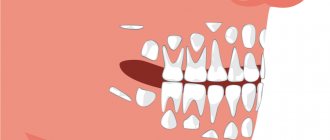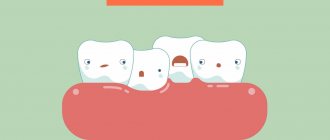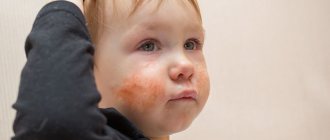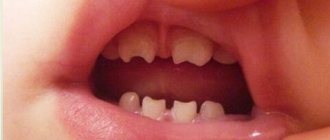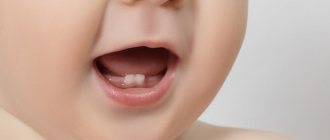Each age period is characterized by both certain characteristics of tooth decay and diseases that predominantly manifest themselves in a specific period.
Therefore, each age period has its own characteristics when providing dental care to children. The ability to find an approach to a child psychologically and the ability to make the right decision under certain circumstances are primarily among the features of age-related treatment.
Among the questions most often asked by parents, the leading questions are about the timing of teething and the physiological change of baby teeth to permanent ones. Moms and dads are interested in how many teeth a child should have at a certain age, which tooth should erupt first, and much more. Therefore, especially for you, the dentists of the 32 Dent clinic have created a section in which you will find answers to all your questions about the age-related characteristics of dental development.
Why are the first teeth called baby teeth?
There are several opinions on this matter. Doctors attribute the authorship of the term to Hippocrates, who believed that these teeth are formed from mother's milk. Philologist N.N. Vashkevich states that “the term is a tracing from the Latin lactose “milk”. But the tracing paper is false, it is a misunderstood Arabic liwaqt - “for a while,” “temporary.”
One way or another, the first teeth actually actively “feed” on breast milk, since it is from it that the child absorbs the main building material of teeth and bones – calcium. And although baby teeth erupt, as a rule, at 6-7 months, their formation in the child’s jaws occurs long before that.
It is worth noting that for the health and strength of the first teeth, it is mother’s milk (not cow’s) that is necessary, since the nutrients from it are maximally absorbed by the baby’s body. Therefore, the universal recipe “breastfeed your baby” will help in this matter.
When do baby teeth appear?
The rudiments of baby teeth appear in the embryo at about 5-7 weeks of pregnancy. By the time a child is born, the crowns of 10 temporary and 8 permanent teeth have already been formed in his jaws. The timing of the eruption of baby teeth is quite arbitrary. The average formula is as follows: the child’s age in months minus 6. That is, the first 2 teeth (usually the lower middle incisors) appear at 6-7 months, the next 2 (upper middle incisors) at 8-9 months. Next, the upper lateral incisors usually come out, then the lower lateral incisors, then the front molars, canines, and back molars. Thus, by the age of 2-2.5 years, the child should have all 20 milk teeth. These are ideal timing and ideal sequence; deviations from them are quite common. Teeth may begin to appear as early as 4 months, or may linger for up to 8-9 months. In rare cases, a baby is born with teeth already erupted.
If your little one doesn’t “meet the deadline,” don’t be alarmed. This does not mean that the child is developmentally delayed. You should also not be proud of the early appearance of teeth - it does not indicate the child’s superpowers. Early or late appearance of teeth may be a hereditary factor. In case of a strong deviation from the schedule - the appearance of teeth before 4 months or their absence after 9 months - just show the baby to the pediatric dentist. In general, the first examination by a pediatric dentist should be scheduled at least when the child is one year old. The doctor will see how the teething process is progressing and talk with you about the baby’s oral hygiene. The baby will get acquainted with the environment of the office, with the doctor, will get the first positive experience of visiting the dentist, because nothing unpleasant awaits him during this visit, and funny pictures on the walls of the clinic, toys, a chair in which he can ride with his mother - all this will certainly have an impact on him. him a good impression. From now on, you should take your child to the pediatric dentist at least twice a year.
Clinical picture
The main symptom for all types of flux is severe toothache at the site of infection, sometimes diffuse (with extensive bone damage). Swelling gradually begins to increase: first it is localized above the site of inflammation, and then along the surrounding tissues, sometimes affecting the neck, temple and eye.
Important! Sometimes flux occurs painlessly or with a mild pain effect, which, as a rule, indicates the development of a chronic form with sluggish inflammation and periodic relapses.
Inflammation is accompanied by the following symptoms:
- pulsation at the site of the lesion;
- increase in body temperature to subfebrile and febrile levels;
- headache;
- enlarged lymph nodes on the affected side;
- weakness, lethargy, lack of appetite;
- pain when swallowing, talking, opening the mouth;
- pain when pressing on the gum;
- redness of the oral mucosa at the site of the lesion.
My baby is teething - how can I help him?
The child's profuse salivation will tell you that the first tooth is on the way. 1-2 months before the first tooth erupts, the baby’s saliva begins to flow so actively that it is already difficult to do without aprons and bibs.
All your older relatives will probably tell you about the unpleasant side effects of teething. However, there are many misconceptions here.
The very first teeth usually come out painlessly. What most often happens is this: while spoon-feeding a child, the mother hears the sound of metal on the edge of a tooth - that is, she detects an event that has already happened, without even noticing anything unusual in the child’s behavior.
The emergence of canines and molars may be more difficult. The baby may be capricious, refuse to eat, sleep poorly, and put everything in his mouth. You should take care of inflamed gums - regularly treat them with special gels, offer your child to chew a cooling ring (cold relieves pain well).
However, do not believe that an increase in temperature is associated with teething. Fever and catarrhal symptoms are caused by an infection that is “caught” by the child’s body, weakened by malnutrition and lack of sleep. That is why, during the period of teething, it is better to protect the baby from communicating with strangers. Digestive disorders, an upset stomach of a child at the time of teething, is associated with his desire to chew and suck everything he can reach, just to relieve discomfort in the gums. This is how pathogenic microbes enter his mouth. Try to surround your child with clean objects, wash his hands and toys more often. Regularly let your baby chew small pieces of solid food - dried bread, bagel, apple slice, etc. This will help the teething of those teeth that are already “on the way”, improve blood supply, and therefore nutrition of the gums, develop the chewing reflex, and help the formation of the speech apparatus.
Life cycle of teeth
Almost all the organs of our body are formed in the womb. Teeth are no exception. Already at the age of 6 weeks, the rudiments of the first teeth appear in the fetus: 10 pieces each. on the upper and lower jaw. Total - 20 small “buds”. This is the future milk bite.
See an interesting infographic about what kind of life our teeth live, and immediately after - in more detail about each stage and useful tips on how to preserve your teeth until old age.
Life cycle of teeth
| Birth | A child is born with fully formed tooth buds - they are located just under the surface of the gums. It is also interesting that some babies are already born with one or more teeth |
| 2-3 months | The baby begins to cut his first teeth. This is a rather unpleasant process, which is accompanied by excessive salivation, pain, deterioration of the child’s mood, and refusal to eat. In addition, during teething, local immunity is significantly reduced, which increases the risk of developing a viral infection. This explains the frequent increase in temperature during this period. |
| 6-14 months | Teeth begin to appear. The lower incisors grow first, then the upper ones. In total, the child should grow 20 pieces, including 2 multi-root chewing ones on each side - this will be the milk bite |
| 6-7 years | At this time, “baby” teeth begin to fall out. There is a change from a milk bite to a permanent one |
| 12-13 years old | The period of complete completion of the formation of a permanent dentition. By this age, the milky ones should fall out completely, and permanent ones should grow in their place. Helping teeth fall out in most situations is not required - this is a natural and physiological process that does not require third-party intervention. But it’s still worth seeing a doctor: it’s important to monitor both the wound and the process as a whole |
| 17-21 years old | During this period, “wisdom teeth” – the furthest ones in the row – may grow. There are 4 of them in total. There were no dairy predecessors in their place, so they have to pave the way on their own. In addition, they grow at a time when the bone tissue is fully formed and very hard. That is why their growth is associated with such problems as pain, acute inflammation of the mucous membrane, incorrect position in the row and even retention (the tooth does not erupt, forms and remains completely in the bone tissue) |
| 20 years and older | Starting at this age (and if there are problems with the body or when playing dangerous sports, even earlier), we begin to lose teeth. In the absence or poor hygiene, with poor nutrition, and the appearance of diseases of many organs and systems of the body, the enamel becomes weaker and is subject to attack by bacteria. With age, the amount of saliva decreases - and it is this that is a natural means of cleansing plaque. This is largely why teeth and gums become more susceptible to decay. It is also worth remembering that not only dental diseases, but also problems with gums lead to loss. |
When should you start brushing your child's teeth?
Now pediatric dentists are inclined to believe that systematic cleansing of a child’s oral cavity should begin... from the first days of his life. After feeding, you need to take clean gauze or a bandage, wrap it around your finger, moisten it with boiled water and rub it over the newborn’s gums. This is how you can avoid such major troubles as, for example, oral candidiasis (thrush).
Cleaning the first teeth can be done with a cotton swab or fingertip. You should start using toothpaste and brushing at 12-14 months. Almost all children's brushes are now made from soft artificial bristles, but still be careful and check the brush you like: what age it is designed for, and whether it is soft enough. Give preference to products from well-known manufacturers. Toothpaste also differs in composition and taste depending on the age of the children for whom it is intended. The child should be explained that toothpaste should be spat out, even though it is sweet. However, keep in mind: nothing bad will happen if a child swallows a certain amount of paste at first: manufacturers are aware of this tendency of children and make children's pastes safe for the body.
Of course, it is necessary to involve the child in the dental care process as much as possible: show how to use a brush correctly, brush your teeth in the presence of the child, thereby demonstrating how important this procedure is. You can involve your baby in the process of choosing toothpaste and brush, especially since the brush needs to be changed every 3 months. A slightly older child can be asked to choose brushes for the whole family. It is necessary to develop in your child the skill of regular brushing of teeth 2 times a day. More attention should be paid to brushing your teeth at night. And yet, you can let go of the situation and leave the child to his own devices in matters of oral hygiene only when the child turns 10 years old.
How to treat a dental cyst
If a cyst appears in a tooth, what should you do? At the first signs of pathology, you should seek help from a doctor. The specialist will listen to complaints, conduct an examination of the oral cavity, and refer you for an X-ray examination. Treatment tactics depend on the extent of the inflammatory process.
Conservative methods
Therapeutic treatment of the disease is permissible in the initial stages, when the size of the cavity does not exceed 5 - 8 mm. Another prerequisite is good patency of the root canal, under which the cyst is located. General scheme of therapeutic treatment:
- Hard tooth tissues are prepared.
- Expand the entrances to the canal.
- The pulp is removed.
- Expand the lumen of the canal.
- Antiseptic and medicinal treatment of cavities is carried out.
- Temporary filling with dental paste, which accelerates the restoration of damaged tissue.
Treatment is long-term, taking from several months to 1 - 2 years. The patient periodically visits the doctor for follow-up examinations and repeated medicinal treatments. To suppress the growth of bacterial flora, a course of antibiotic therapy is usually prescribed. If control X-rays confirm the success of treatment, then a permanent filling is installed.
Surgical intervention
The operation is performed if the tooth formation is large, located in a hard-to-reach place, therapeutic treatment has not given a positive result, etc. Invasive intervention can be carried out according to different protocols
Cystectomy
Operation cystectomy - removal of the tumor along with the damaged root segment. This is a tooth-saving procedure. It is performed in the presence of a small tumor (extending no more than 2 teeth). How to remove a cyst on the root of a tooth:
- administration of local anesthetic;
- cut the gum above the formation;
- gain access to the capsule;
- remove the tumor;
- in case of union with the root, resection of its apex is performed;
- a bone-restoring drug is placed inside the resulting cavity;
- stitches are placed.
In the postoperative period, the patient is prescribed drug therapy.
Hemisection
Used on multi-rooted teeth. During the intervention, the destroyed root is amputated along with part of the crown and the capsule is removed. The cavity is filled with a polymer composition, the upper part is expanded with a composite material or prosthetic crown.
Cystotomy
The operation consists of resection of the anterior wall of the cyst. The contents of the capsule are pumped out through the formed hole, which eliminates internal pressure. This leads to a gradual reduction of the cavity. The manipulation is low-traumatic, but requires careful postoperative care.
Tooth extraction
Tooth-preserving operations cannot be used in all cases. In some clinical situations, it becomes necessary to remove a tooth. Indications for such a decision may include:
- significant size of education;
- the presence of an extensive zone of bone destruction around the segment;
- tumor growth into the maxillary sinus;
- other methods did not work.
After surgical treatment, the doctor gives recommendations on oral care in the postoperative period. If you ignore the dentist's advice, after removal of a dental cyst, adverse consequences are possible: wound infection, bleeding, relapse.
Diseases of baby teeth
The most common troubles are caries (including bottle caries), pulpitis, periodontitis.
You should be alerted to any changes in the color of the enamel, spots, dots (both dark and white) on the child’s teeth, redness or swelling of the gums. But you don’t have to be afraid of uneven teeth at first: when chewing solid food, the baby teeth will move a little and gradually take the right place.
The causes of diseases in primary teeth are not very different from the causes of problems with permanent teeth. This:
- insufficient care for them (lack of proper hygiene),
- eating disorders,
- undermining of the immune system due to other diseases and taking certain medications.
It is a mistake to think that you can't take too much care of your baby teeth because they will fall out anyway. A diseased tooth in the mouth is a breeding ground for pathogenic bacteria, which not only destroy other teeth, but also negatively affect digestion and ENT organs. A prematurely lost baby tooth is also a problem, as it does not allow the baby to fully chew food or articulate sounds well. In addition, neighboring teeth try to occupy the vacated space - they move. And when a permanent tooth begins to grow here, it simply does not have enough space in the dentition and will have to grow sideways. That’s why it’s imperative to keep an eye on your baby teeth and treat them on time!
We ourselves, out of ignorance, introduce some pathogenic bacteria into the baby’s oral cavity. Suffice it to remember my grandmother’s method of disinfecting a fallen pacifier: lick it and put it in the baby’s mouth. How many times have we done this? Did you feed the child with your spoon? Did you take turns biting an apple or a bun with him? Imagine for a moment the state of your teeth and the newly formed, not fully formed, delicate teeth of the child. What danger did you expose them to?
Foreign microflora is especially harmful to a child under 2 years of age, while temporary teeth are maturing in his mouth and their enamel is very vulnerable.
Leftover food also contributes to the rapid proliferation of bacteria in the oral cavity. A by-product of their activity is acid, which eats away the enamel of a baby tooth, leaving its delicate base - dentin - without protection. Then it’s a matter of little things: microorganisms penetrate the dentin and destroy it. This is how caries occurs. Outwardly, a diseased tooth may look normal for quite some time: a small black dot (the site of the lesion) is not too noticeable. But inside it can already be severely damaged, since caries of baby teeth, due to the softness of their tissues, develops much faster than permanent teeth.
There is also the so-called “bottle caries” - this is a brownish plaque on the front teeth. It is very resistant and cannot be cleaned with a brush. Such teeth rot quickly. This caries is called “bottle caries” because it is a consequence of feeding the baby from a bottle with sweet drinks and juices at night and throughout the night. Carbohydrates are known to be the best food for bacteria. Receiving such wonderful nutrition, pathogenic bacteria rapidly multiply and take over the entire territory available to them. It will be very difficult to force them to give up their positions. The development of “bottle caries” is also facilitated by the fact that at night the natural protector and cleaner of teeth – saliva – is almost not produced. While you are sleeping peacefully, your baby’s fragile little teeth are under powerful attack and are not protected by anything! Is it worth it to buy yourself a vacation at such a price?
Dangerous complications of caries are pulpitis and periodontitis.
Pulpitis is an inflammation of the pulp (the core of the tooth, filled with vessels and nerve fibers). In children, the pulp is practically insensitive, so they may not feel the usual sign of pulpitis - sharp pain. As a result, pulpitis of baby teeth may not be noticed even by an attentive parent, and the role of preventive examinations by a dentist is irreplaceable here.
If bacteria pass through the root of a baby tooth and enter the gum tissue, inflammation begins - periodontitis. Severe pain and fever are already guaranteed here. The gums become red and swollen. Periodontitis is a serious disease, and a child should never be exposed to it.
By visiting your dentist in a timely manner, you can avoid all these troubles. Caries is very easy to treat. Here, however, the first question comes to mind: where exactly to turn. It turns out that the approach to the treatment of baby teeth in different clinics is very different.
Traditionally, caries of primary teeth is treated “in a hurry”: a small child usually does not really want to endure while the doctor picks around his mouth, so the doctor tries to somehow clean the damaged area and fill it with quick-hardening material. As a result, the affected teeth remain untreated and may soon become inflamed again or completely collapse. Sometimes you even have to put crowns on baby teeth.
“The Nutcracker” uses all the possibilities of modern medicine to provide comprehensive care to the smallest patients: from composite materials to “laughing gas” and Sevoran anesthesia. We are convinced that the treatment of primary teeth should be of high quality, and the child’s impressions of the clinic should be the most pleasant.
Characteristic age-related changes during growth
Eruption of the crown means that it becomes vulnerable to external factors, which include both pathogenic bacteria and mechanical stress. The enamel and dentin layers undergo the first changes - studies show that the height of teeth decreases by an average of 0.035 mm every year, which is caused by the wearing off of the protective coating. A more intense decline is a pathological sign, as well as a consequence of the abuse of bad habits.
With age, the natural shade and structure of the enamel coating changes. Cracks and chips form, coloring pigments accumulate, and areas are formed through which plaque containing pathogenic microorganisms penetrates into the fabric. It is worth noting that the human body does not have a mechanism for regenerating tooth enamel, so any damage requires a medical examination and, if necessary, comprehensive treatment that eliminates negative consequences.
Age-related changes in the pulp
Aging also affects the internal structure of teeth. A reduction in pulp volume, as well as the formation of fibrous deposits, leads to the accumulation of minerals that worsen the condition of the internal vessels and capillaries that provide nutrition to the element. Among patients in the older age group, pulpal atherosclerosis is often diagnosed, which results in fragility and vulnerability of the teeth.
Changes in bone and gum tissue
Another characteristic sign of age-related changes is a decrease in the density of the bone tissue structure, expressed in a reduction in height, as well as the manifestation of excessive mobility of elements of the dentition. Jaw osteoporosis is considered a common pathology, affecting patients over 50 years of age. In addition, weakening of bone tissue leads to adentia - tooth loss - which results in incorrect distribution of the chewing load, leading to atrophy.
Negative processes also affect the soft tissues of the oral cavity. Gum recession, as a rule, is the result of the development of periodontal pathologies, genetic predisposition, non-compliance with medical recommendations and the presence of bad habits. Ultimately, age-related changes lead to complete tooth loss, requiring surgical dental treatment. At the same time, premature adentia can be avoided by regular visits to the doctor, which include preventive and physiotherapeutic procedures, as well as the restoration of individual lost or destroyed units.
What should you do to keep your baby teeth healthy?
Let’s summarize all those simple and, in general, obvious rules that will help us preserve the baby’s healthy baby teeth given by nature throughout the entire period of their functioning and not lead to the moment when the child’s baby tooth hurts or its premature loss occurs.
- Avoid unnecessary use of medications during pregnancy and breastfeeding to avoid damaging developing teeth.
- Eat right during pregnancy.
- Feed your baby breast milk.
- Introduce solid foods into your child's diet in a timely manner.
- Do not share food with your child (especially before the age of two), and do not lick his pacifier for the purpose of “disinfection.”
- Don't let your child fall asleep with a bottle of sugary drink.
- Carefully monitor your child’s oral hygiene from the first days of life.
- Have your child undergo regular preventive examinations with a pediatric dentist.
